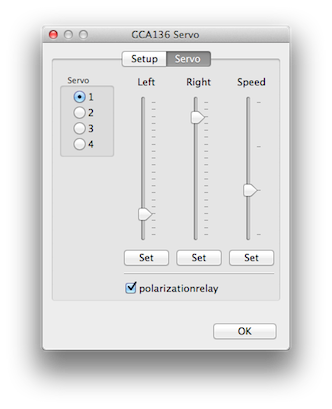Table of Contents
GCA136 Servo
Introduction
The programming is established with plain switch commands without any feedback from the servo-controller.
Previous settings of GCA decoders are saved in the rocview.ini for later use.
To activate this setup menu, select Programming > GCA > GCA136
Setup


Remarks on programming GCA136 with RocNet:
Due to a serious difference in timing with Raspbery Pi running RocNet,
it might happen that programming will not start the first time after initiation.
In that case, just restart programming.
| Even if not all servo connections are used, it is necessary to have all 4 addresses / ports set, because the programming commands are transmitted in parallel as a series of coded 4-bit values. |
|---|
Interface ID
Only needed if the decoder is not connected to the default interface.
| The programming is done with normal switch commands so the GCA136 could be connected to a none GCA accessory decoder. The SV IID does not affect this dialog. |
Bus
See: Addressing
Address/Port
Normal Rocrail addressing.
The four addresses must be followup pins on one decoder like the GCA50.
With LocoIO (GCA50) will setup here Address = “0” and Port = “Address of LocoIO port”.
Single gate
Use this option ONLY if the GCA136 is connected to the CAN-GC2 or another flat addressing system.
ON
Set all outputs to the default position and activate programming mode.
OFF
Deactivate programming mode.
Servo

For GCA136 and compatible servo controllers.
Programming commands are send directly after releasing the thumb of the sliders or by selecting the relay or servo selection.
Left/Right angle
Adjustable right and left rotation angle to meet the environment of the servo.
Speed
Servo speed selection.
Polarization Relay
Position of the polarization relay,situated on the addional GCA137. » For 2-rail systems only!

